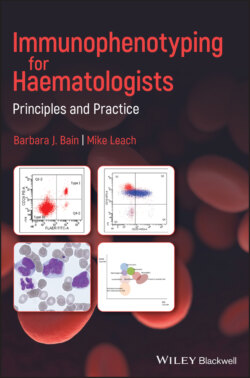Immunophenotyping for Haematologists

Реклама. ООО «ЛитРес», ИНН: 7719571260.
Оглавление
Barbara J. Bain. Immunophenotyping for Haematologists
Table of Contents
List of Tables
List of Illustrations
Guide
Pages
Immunophenotyping for Haematologists. Principles and Practice
Preface
Acknowledgement
Abbreviations Used in the Book
Part 1 Purpose and Principles of Immunophenotyping. CONTENTS
Flow Cytometric Immunophenotyping
Immunohistochemistry
Interpretation and Limitations of Flow Cytometric Immunophenotyping
Problems and Pitfalls
References
Bibliography
Part 2 Immunophenotyping for Haematologists. CONTENTS
A Compendium of Antibodies and Patterns of Expression of Equivalent Antigens in Normal and Neoplastic Cells
Abbreviations
Antibodies with CD numbers. CD1
CD2
CD3
CD4
CD5
CD7
CD8
CD9
CD10
CD11a
CD11b
CD11c
CD13
CD14
CD15
CD16
CD19
CD20
CD21
CD22
CD23
CD24
CD25
CD26
CD27
CD28
CD30
CD31
CD32
CD33
CD34
CD35
CD36
CD37
CD38
CD40
CD41a
CD41b
CD42a
CD42b
CD42c
CD42d
CD43
CD44
CD45
CD47
CD49b
CD52
CD54
CD55
CD56
CD57
CD58
CD59
CD61
CD64
CD65
CD66a–e
CD68
CD68R
CD71
CD79a
CD79b
CD80
CD81
CD86
CD94
CD99
CD103
CD105
CD107a
CD110
CD116
CD117
CD123
CD127
CD133
CD135
CD138
CD157
CD158a–k
CD160
CD161
CD163
CD180
CD200
CD203c
CD207
CD227
CD229
CD235a
CD235b
CD236
CD236R
CD241
CD246
CD269
CD274
CD279
CD300e
CD303
CD304
CD305
CD319
CD324
CD326
CD335
CD340
Antibodies without CD numbers. κ
λ
γ
α
μ
δ
ε
7.1
ALK1
annexin A1
basogranulin
BCL2
BCL6
BCL10
BOB.1
BRAFV600E
calprotectin
carcinoembryonic antigenCD66e;
chromogranin
cyclin D1
cytokeratin
DBA.44
desmin
E‐cadherin
eosinophil major basic protein
eosinophil peroxidase
Ep‐CAM
epithelial membrane antigen
ERG
FLI1
fluorescent aerolysin (FLAER)
FMC7
glycophorin
granzyme
HER2
HHV8‐LANA1
HLA‐DR
immunoglobulin
Ki‐67
KIT
LEF1
immunoglobulin
lysozyme
mast cell tryptase
melanA
MNDA
MUM1/IRF4
MYC
myeloperoxidase (MPO)
myoglobin
neutrophil elastase
NG2
NPM1
OCT‐2
PAX5
perforin
programmed cell protein 1
programmed cell death ligand 1
prostate‐specific antigen
prostatic acid phosphatase
ROR1
rough endoplasmic reticulum‐associated antigen
S100
SOX11
synaptophysin
tartrate‐resistant acid phosphatase
‐cell receptor (TCR) αβ
T‐cell receptor (TCR) γδ
terminal deoxynucleotidyl transferase (TdT)
TIA‐1
TP53
von Willebrand factor
ZAP70
Bibliography
Websites
Part 3 Immunophenotyping in the Diagnosis and Monitoring of Haematological Neoplasms and Related Conditions with Tables and Figures for Quick Reference. CONTENTS
Abbreviations
Normal Peripheral Blood and Bone Marrow Cells, Lineage and Stem Cell Markers
Acute Myeloid Leukaemia
Immunophenotype of Cells of Specific Myeloid Lineages
Correlation of Immunophenotype with Genotype
Acute Lymphoblastic Leukaemia, Mixed Phenotype Acute Leukaemia and Undifferentiated Acute Leukaemia
B‐lineage Acute Lymphoblastic Leukaemia
Haematogones and Their Distinction from B Lymphoblasts
T‐lineage Acute Lymphoblastic Leukaemia
Acute Mixed Phenotype Leukaemia and Acute Undifferentiated Leukaemia
Myelodysplastic Syndromes and Myelodysplastic/Myeloproliferative Neoplasms
Myeloproliferative Neoplasms
Systemic Mastocytosis
Blastic Plasmacytoid Dendritic Cell Neoplasm
Langerhans Cell Histiocytosis and Erdheim–Chester Disease
Histiocytic Sarcoma
Mature B‐lineage Neoplasms
Chronic Lymphocytic Leukaemia
Mantle Cell Lymphoma
Follicular Lymphoma
Marginal Zone Lymphomas
Lymphoplasmacytic Lymphoma/Waldenström Macroglobulinaemia
Prolymphocytic Leukaemia
Hairy Cell Leukaemia
Hairy Cell Leukaemia Variant
Splenic Diffuse Red Pulp Small B‐cell Lymphoma
Burkitt Lymphoma
Diffuse Large B‐cell Lymphoma
Primary Mediastinal Large B‐cell Lymphoma
Primary Effusion Lymphoma
Intravascular Large B‐cell Lymphoma
High‐Grade B‐cell Lymphoma with Rearrangement of MYC and BCL2, BCL6 or both
Plasmablastic Lymphoma
Persistent Polyclonal B‐cell Lymphocytosis
Plasma Cell Neoplasms. Multiple Myeloma (Plasma Cell Myeloma)
Plasma Cell Leukaemia
Light Chain‐associated Amyloidosis
Hodgkin Lymphoma
Mature T‐lineage and NK‐lineage Neoplasms
T‐cell Prolymphocytic Leukaemia
Adult T‐cell Leukaemia/Lymphoma
Angioimmunoblastic T‐cell Lymphoma
Hepatosplenic T‐cell Lymphoma
Primary Cutaneous γδ T‐cell Lymphoma
Anaplastic Large Cell Lymphomas
Lymphomatoid Papulosis
Sézary Syndrome
Mycosis Fungoides
Intestinal T‐cell Lymphomas
T‐cell Large Granular Lymphocytic Leukaemia
Chronic Lymphoproliferative Disorder of NK Cells
Aggressive NK‐cell Leukaemia
Extranodal NK/T‐cell Lymphoma, Nasal Type
Systemic EBV‐positive T‐cell Lymphoma of Childhood
Minimal Residual Disease
Acute Lymphoblastic Leukaemia
Acute Myeloid Leukaemia
Chronic Lymphocytic Leukaemia
B‐lineage Non‐Hodgkin Lymphoma
Hairy Cell Leukaemia
Multiple Myeloma
Paroxysmal Nocturnal Haemoglobinuria
Non‐haematological Tumours
Conclusion
References
Bibliography
Websites
Part 4 Test Yourself. CONTENTS
Abbreviations
Short Answer Questions (Single Best Answer) SAQ 1
SAQ 2
SAQ 3
SAQ 4
SAQ5
SAQ 6
SAQ 7
SAQ 8
SAQ 9
Extended Matching Questions. EMQ 1
EMQ 2
EMQ 3
EMQ 4
FRCPath‐Type Questions
Case 1
Case 2
Case 3
Case 4
Case 5
Case 6
Case 7
Case 8
Case 9
Case 10
Case 11
Case 12
Case 13
Case 14
Case 15
Case 16
Answers to SAQs. SAQ 1
SAQ 2
SAQ 3
SAQ 4
SAQ 5
SAQ 6
SAQ 7
SAQ 8
SAQ 9
Answers to EMQs. EMQ 1
EMQ2
EMQ 3
EMQ 4
Answers to FRCPath‐Type Questions. Case 1
Case 2
Case 3
Case 4
Case 5
Case 6
Case 7
Case 8
Case 9
Case 10
Case 11
Case 12
Case 13
Case 14
Case 15
Case 16
References
Further Reading
Index
a
b
c
d
e
f
g
h
i
k
l
m
n
o
p
r
s
t
u
v
w
z
WILEY END USER LICENSE AGREEMENT
Отрывок из книги
Barbara J. Bain, MB BS, FRACP, FRCPath
Professor of Diagnostic Haematology
.....
Back gating is a process whereby a target population identified in one approach can be tracked in another. For example, CD34+ myeloblasts can be isolated using CD34 versus SSC, then colour tracked into the FSC versus SSC plot to show cell size and granularity. With modern multichannel instruments it is possible to study 6–8 or more antigens in a single tube. If multiple tubes are studied, several core antibody‐fluorochrome conjugates can be included in each tube analysed so that cross‐comparison between the same cells stained with different antibody panels in different tubes is possible.
Figure 1.4 Delineation of peripheral blood or bone marrow B‐cell populations using CD19 expression and SSC.
.....